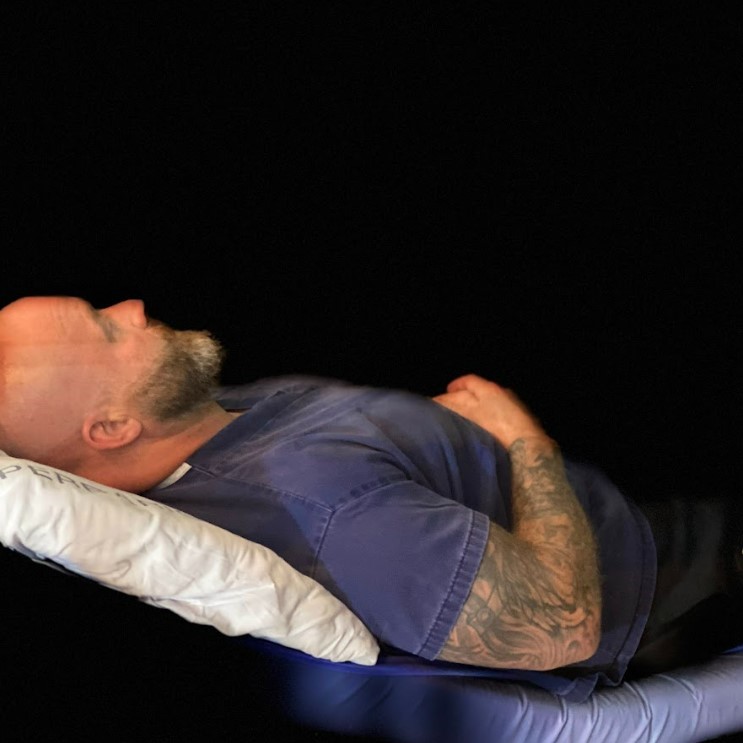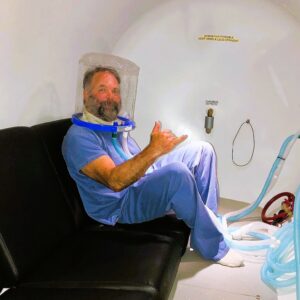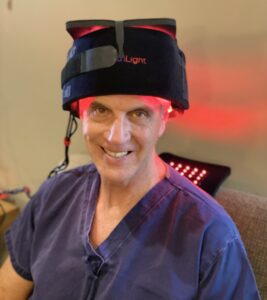Healing Traumatic Brain Injury/Post Concussion Syndrome
Hyperbaric Oxygen Therapy and Near Infrared Light Therapy

About the Treatment
Traumatic brain injury (TBI) is a complex condition that affects millions of people worldwide, often resulting in long-term disabilities and cognitive impairments. Traditional treatment options are limited, and patients often face long and challenging recovery journeys. As medical science advances, researchers and clinicians are continuously turning to hyperbaric oxygen therapy (HBOT) and near infrared light therapy as an adjunctive therapy for TBI.
Hyperbaric Oxygen Therapy:
HBOT involves the administration of 100% oxygen in a chamber with increased atmospheric pressure. The elevated pressure allows for a higher concentration of oxygen to dissolve in the bloodstream, promoting its delivery to all tissues, including the injured brain. This increased oxygen availability serves multiple therapeutic purposes.
Near Infrared Light Therapy:
Near infrared light therapy involves the use of specific wavelengths of light to stimulate cellular activity and promote healing. It utilizes non-thermal, low-energy light to penetrate deep into the tissues of the brain, activating biochemical processes that enhance cellular metabolism and improve overall brain function. It can be used in conjunction with HBOT for the treatment of traumatic brain injury.
A Simple Process
Hyperbaric oxygen therapy and near infrared light therapy are generally considered safe, with few adverse effects reported. However, it is crucial to undergo HBOT under the supervision of trained professionals and adhere to established protocols to ensure safety and maximize potential benefits. We use 100% medical grade oxygen in FDA approved, hard shell chambers. Our program allows for personalized, effective care for optimal treatment and results which includes:
- Patient consults with our patient care coordinator to discuss medical history, symptomatology and goals of therapy.
- A complete medical evaluation and baseline assessments are conducted with a licensed hyperbaric medical doctor and patients are cleared for treatment.
- A personalized treatment protocol is developed
- The protocol is implemented. Patients will complete typically 40 sessions (although more my be indicated) of HBOT, 60-minute dives, 5 days per week Monday through Friday, for 8 weeks.
- Post assessments will be conducted within ten days of completion.
- Patients meet with the patient care coordinator to discuss results and follow-on therapy.
Healing Mechanisms of HBOT and Near Infrared Light Therapy
Healing Mechanisms of HBOT:
1. Enhanced Oxygenation: HBOT improves oxygen supply to damaged brain tissues, supporting the energy-intensive healing processes and potentially mitigating secondary injury mechanisms.
2. Reduced Inflammation: Inflammation plays a crucial role in TBI progression. HBOT has been shown to modulate the inflammatory response, reducing the release of pro-inflammatory substances and promoting the production of anti-inflammatory agents.
3. Neovascularization and Angiogenesis: HBOT stimulates the formation of new blood vessels, enhancing blood flow to the injured areas of the brain. This increased circulation helps deliver vital nutrients and promotes tissue repair.
4. Neuroplasticity and Neurogenesis: HBOT has shown the potential to promote neuroplasticity, the brain’s ability to reorganize and form new connections. It may also stimulate neurogenesis, the generation of new neurons, which could aid in the recovery and regeneration of brain tissue.
Healing Mechanisms of Near Infrared Light Therapy:
Near infrared light therapy works through several mechanisms to benefit individuals with traumatic brain injury:
1. Increased Blood Flow: Near infrared light stimulates the production of nitric oxide, a molecule that dilates blood vessels and improves blood flow. Enhanced blood circulation delivers vital oxygen and nutrients to injured brain tissue, facilitating the healing process.
2. Reduced Inflammation: TBI triggers an inflammatory response in the brain, which can exacerbate damage and hinder recovery. Near infrared light therapy has been found to alleviate inflammation by modulating the activity of inflammatory cells and reducing the release of pro-inflammatory molecules.
3. Enhanced Cellular Function: Near infrared light therapy promotes the production of adenosine triphosphate (ATP), the energy currency of cells. This boost in cellular energy supports the repair and regeneration of damaged brain cells, leading to improved cognitive function and neurological recovery.
4. Neuroprotection: Near infrared light therapy has demonstrated neuroprotective effects by preventing further damage to brain cells. It helps mitigate secondary injury cascades, such as oxidative stress and mitochondrial dysfunction, that can occur after TBI.
Understanding Traumatic Brain Injury/Post Concussion Syndrome
Understanding Traumatic Brain Injury:
Traumatic brain injury occurs when an external force causes damage to the brain, leading to a wide range of physical, cognitive, and emotional symptoms. Common causes include a sports collision, a fall or a motor vehicle accident. In our military, common causes are repeated exposure to gunfire, explosions, falls or other accidents resulting it head trauma. The initial injury triggers a cascade of events, including inflammation, oxidative stress, and impaired oxygen supply to brain tissues. These processes can further exacerbate brain damage and hinder the natural healing mechanisms.
HBOT and near infrared light therapy are non-invasive and well-tolerated treatment options. They do not involve surgery or medications and are generally considered safe, with minimal side effects. Research and clinical results show these therapies are effective months or years after the original injury has taken place and the results are lasting. We have been helping our civilian and military neighbors heal since 2012.
Hyperbaric oxygen therapy is used thousands of times a day in hospitals to heal external wounds. Here, we use it to heal wounds inside the brain and bodyas well. Contact us today for a consultation 757-452-3934.

